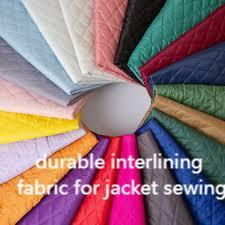In the world of garment construction, Interlining plays a crucial role in enhancing the durability and structure of clothing items. By incorporating quality interlining materials, manufacturers can improve the appearance, feel, and longevity of their products. The right supportive layer not only reinforces fabric but also ensures garments retain their shape through daily wear and washing cycles.
Structural Reinforcement and Improved Fit
Adding a support layer significantly strengthens areas such as collars, cuffs, and waistbands. This reinforcement prevents garments from losing their shape, ensuring a consistent fit and polished appearance. The extra layer also contributes to wrinkle resistance, which helps maintain a fresh, professional look for longer periods.
Variety of Materials and Application Techniques
There are numerous types of support fabrics available, each suited for specific garment needs. Fusible options are favored for their ease of application through heat bonding, streamlining manufacturing workflows. Sew-in variants offer flexibility and softness, suitable for more delicate or premium fabrics. Specialized versions with properties such as stretch, water resistance, or thermal insulation expand their utility across different clothing lines.
Innovations in Fabric Technology
Recent developments include the use of lightweight, breathable fibers that enhance comfort without sacrificing support. Advanced bonding technologies have improved the durability and washability of garments, allowing for repeated use without loss of function. These innovations align with the growing consumer demand for high-performance apparel that combines aesthetics with practicality.
Environmental Responsibility in Textile Production
Sustainability is becoming a central focus in fabric manufacturing. The incorporation of recycled materials and environmentally friendly adhesives helps reduce the ecological footprint of clothing production. Energy-efficient processes and reduced water consumption further contribute to greener manufacturing practices, appealing to eco-conscious brands and consumers alike.
Selecting the Best Support Layer for Your Garments
Choosing an appropriate support fabric requires an understanding of the garment’s purpose, fabric compatibility, and desired performance characteristics. Important considerations include weight, stiffness, and method of attachment. Collaborating with knowledgeable suppliers ensures access to technical expertise and customized solutions tailored to specific production needs.
The integration of quality support fabrics is essential for producing durable, attractive garments that meet modern consumer expectations. For more information on material options and applications, visit https://www.interlining-factory.com/news/what-is-interlining-types-applications-and-more.html .

